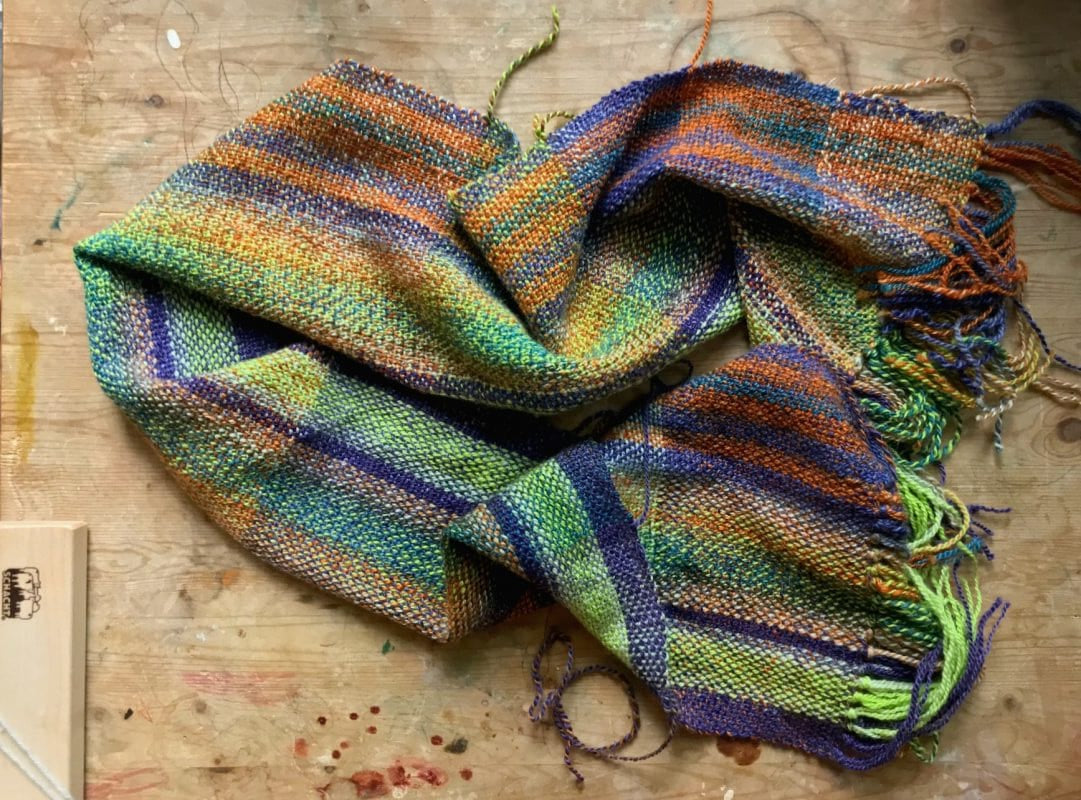By Jillian Moreno
I can’t get enough color in my life! My favorite thing is to spin hand-dyed top because there are so many different ways the colors can play out.
I’ve been dipping my toe into weaving using my Cricket Loom, and I recently got the urge to try weaving hand-dyed handspun yarn. It was surprising and brought up more questions about color and weaving than answers.
At the Dallas/Fort Worth Fiber Fest, I picked up hand-dyed BFL Superwash top from Lisa Souza in two different colorways, Bird of Paradise and Lime & Violet. I knew I wanted to use them to spin and weave; the big question was how.

Since I’m newish to weaving and new to weaving with color, I went for very basic yarns with one color-mixing element in the ply.
I spun three 2-ply yarns on my Flatiron. I plied Bird of Paradise and Lime & Violet on themselves, matching colors in the ply (more or less). My third yarn combined one ply of Bird of Paradise and one ply of Lime & Violet. I spun them to 12 wpi and wove them with a sett of 10 EPI and 8 PPI.
I threaded my 12-inch-wide warp with 4-inch stripes of each yarn, putting the mixed ply yarn in the middle. My weft played out with 6 inches of mixed yarn, 4 inches of Lime & Violet, 4 inches of Bird of Paradise, 30 inches of mixed, 4 inches of Bird of Paradise, and 4 inches of Lime & Violet.
I had no real sense of the color outcome before I started to weave. While I was weaving, I was surprised and fascinated at how the colors played out.

After I rolled my scarf off of my Cricket and stared at it, my first thought was, “weaving is not knitting.” I know, duh, but I didn’t realize just how different color interactions in weaving would be. The visual element of layering in weaving intertwines colors much more than knitting. Knitting mostly places colors side by side and stacked on top of each other. In weaving there is side by side, stacking and interlacing, color can get rich and complex or seriously muddy very quickly.
I had three big thoughts on weaving with color based on this experiment:
1. Weaving uses yarn and color in a very different way than knitting.
Weaving has two distinct elements—the warp and the weft—that need to work together. I had to plan my warp and weft color-wise for their interaction to work. These were both yarns with long color runs. I originally wanted to weave a narrow project, but had to rethink it once I realized that the whole color-run wouldn’t show.

2. Marled yarn in weaving is astonishingly cool.
The spot in the weaving where marled yarns of the same colors intersect made an amazing pattern. It’s visually textured using just plain weave. The lime and teal marled yarns in warp and weft look like stars.

3. Color in weaving gets visually busy very fast.
Because weaving has layers, the colors need to work intermeshed. While I was weaving, I did doubt my choices several times. Once the scarf was off the loom, it came together better than I suspected: the colors relaxed into each other.
I initially thought this scarf would get tossed in my scarf bucket for the fall when I was done, but I have so much to study and think about, it’s waiting patiently in my ”thinking about and make more samples” pile. The outcome of this experiment was fascinating to me and ignited a new fire my brain about color and weaving.

